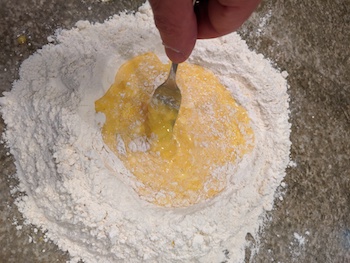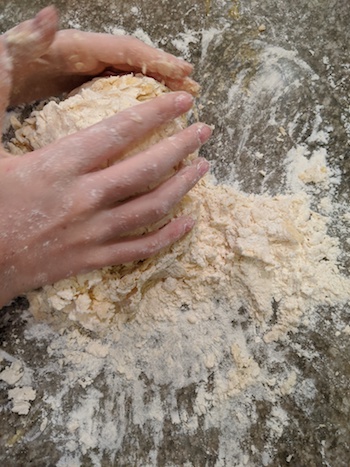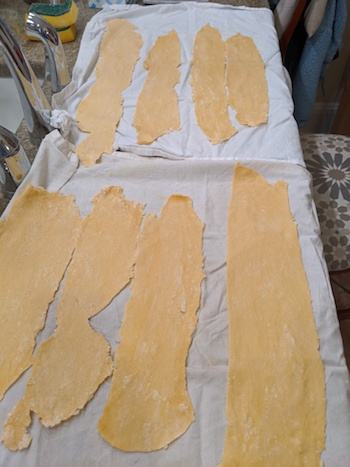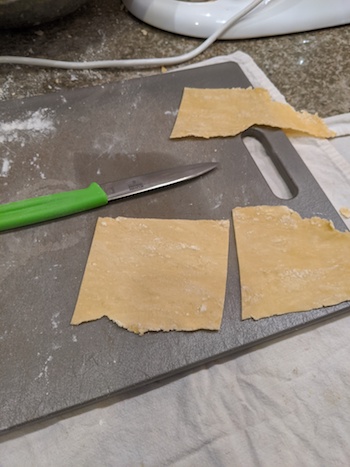Making fresh pasta is fairly labor intensive but cooking right after rolling and cutting the pasta tastes so good. After getting the hang of fresh pasta you can make the pasta faster than going to a supermarket. I have the pasta attachment on a kitchaid mixer. I really like the attachment since it frees up both hands and allows the rollers to continually move at a slow speed. You first roll into sheets then switch rollers and cut. I always use the fettuccine roller. You can hand cut, make fancy custom shapes, or make ravioli. For the sheet roller you start at setting 0 and keep making the sheet narrower. I prefer a thick setting like 5 or 6 for more bite to the pasta. You can go as thin as 8 but it does get harder to manage the sheets when they are thinner. When mixing the dough it can be difficult to get the pasta texture correct. Often it is too sticky or too dry. Letting the dough rest for 20m helps and putting in fridge can also help. Also can be tricky to mix the egg into the flour without breaking the flour wall. It takes some practice to get proficient at the pasta but it is really worth it.
Here is the recipe:
Ingredients
- 3.5 - 4 cups all purpose flour, (490-560g)
- 1 tsp salt
- 5 large eggs
- 1T olive oil
- optionally you could add tomato paste, spinach (careful not to make too wet with liquids), or use squid ink to color the dough
Steps
Make Dough
- mix 1 tsp salt with flour
- put flour in a mound on a large cutting board (or I just put on a clean granite counter)
- with hands make flour well in center keeping high walls of flour
- crack 5 eggs in well of flour, making sure eggs stay in flour walls
- with fork carefully mix eggs
- add 1 T olive oil to eggs

- slowly and carefully with fork mix in flour from walls into eggs
- continue to mix flour until gets thick

- when almost all flour is mixed with hands knead dough until forms a cohesive ball, can discard the flour not mixed
- put dough in bowl and cover. put in fridge for at least a hour
Flatten and cut dough
- Could use a rolling pin or a pasta machine but I really prefer the kitchenaid pasta attachment
- using dough cutter or knife split down in half, then divide further into a total of 10-12 balls.
- flatten each ball into a rectangle or oval about 2-3 inches wide, flatten to about 1/2 inch thick
- if dough is at all stick add flour liberally to both sides
- setup mixer with pasta attachment with adjustable sheet part, set to 0 thickness (widest)
- let dough rectangle flatten through pasta sheet part

- if at all sticky can add flour liberally to both sides
- fold into 3rds and can fold or squeeze ends to make rectangular
- sheet doesn’t have to be perfect since cutting into fettuccine looks fine even with irregular shapes
- fold 2 or 3 times (or more) then when happy with sheet place on a clean towel and move to next dough piece

- when finished making pasta sheets, replace the pasta sheet cutter with the fettuccine cutter or another cutter attachment
- you can also hand cut, make fancy pieces, cut into squares for ravioli, or for really good lasagna keep in sheets

- again liberally apply flour if at all sticky
- Prefer with a knife to cut the pasta sheet into a desired length just to avoid pasta from being too long
- cut each sheet once into a bowl

- add flour liberally to pasta so does not stick
- repeat for each sheet
- really add lots of flour to keep pasta from sticking to each other
Cook pasta
- boil large pot of water, salt the water
- add pasta to water, cook for a few minutes after water gets back to a boil, try a piece